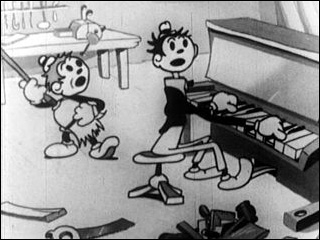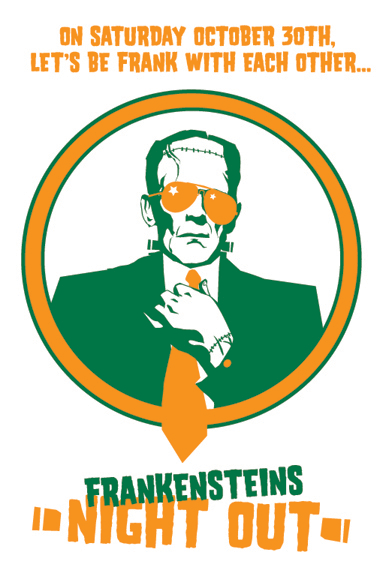Those of you who might be interested in boring stuff like the behind-the-scenes bits of minutiae dealt with by Fantagraphics Books as they assemble their ‘Complete Peanuts’ series: HAVE I GOT THE POST FOR YOU! All sorts of unnecessarily thorough detail!
This thread on the Fantagraphics message board has previews of Canadian cartoonist Seth‘s designs for volumes three and four of ‘The Complete Peanuts.’ Each volume of the hardcover series covers two years worth of strips and will feature a different Peanuts character on the cover. Volumes one and two, released this year, feature Charlie Brown and Lucy respectively. As you can see below, Pigpen and Snoopy have been chosen for next year’s volumes.
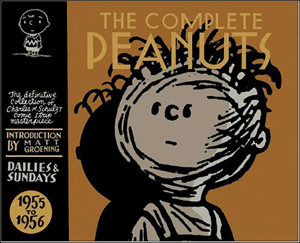
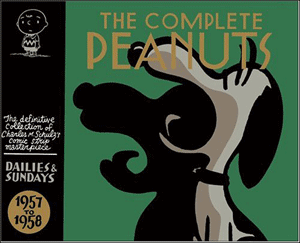
Fantagraphics representative Kim Thompson adds:
“The final cover will have a different colored logo (like the first two, it will be a variant of the main background color but in a metallic ink, but those don’t show up real well on digital images so we’re sticking with the neutral/tan ones for now), a Snoopy image in the upper left hand corner instead of the repeated Charlie Brown (the upper left hand image repeats the main character), and of course the “INTRODUCTION BY —” copy. But it’s good enough as a spaceholder for Amazon.com.”
There is a giant feature on Seth in the latest issue of Comic Art Magazine (AKA the best magazine in the world, ever), which includes some lengthy discussion of the Peanuts designs. I quote liberally from the Comic Art article below, in the hopes that your mind will be blown and you will immediately order a copy of your own.
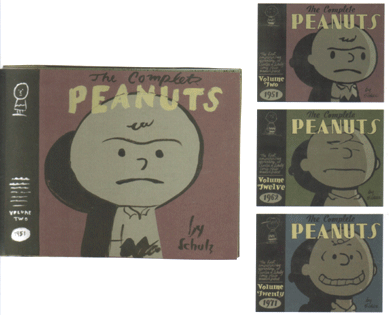
“These are the covers from the Schulz reprint proposal that I presented to Jeannie Schulz. Basically, Gary [Groth] went through all the dealings and then after they’d got things fairly concrete, where it looked like it was going to happen, they brought me down so I could talk to Jeannie and show her what I wanted to do with the book. I went there with a small talk planned, basically to tell her that I felt Schulz’s work was so wonderfully sophisticated and that it had been, I felt, undersold in the last 30 years-pushed as kids’ books, really Pop-y, and that I wanted to try to put together a package of some sort that had some quality of understatement to it. So, here is the production art that I brought down to sell the idea. These fake covers I put together are pretty rough, really. I outlined how the books would fit together and what the design system was…originally. I was planning on one book per year and I wanted to do 50 covers with Charlie Brown’s face on each one. His face would have been taken from the specific year and then you could chart his changes over 50 years. Basically, everybody but me felt that was too much, that we should vary the characters, which is what will happen. This original idea was to demonstrate how much variety there really was just in the Charlie Brown face itself. Conceptually I like it, but I didn’t really expect them to go for that. So, we’ll have 25 books with all the characters appearing once on the covers-one face per book-although Charlie Brown, Snoopy, and Lucy (maybe Linus too) will reappear-Charlie Brown will defmitely be on the first and the last books. Not all the characters can get the cover-but everyone will make the spine. I’ll start the early volumes with the minor characters, like Shermy. Each cover-featured character will dominate that specific volume’s design.”
“In many ways, the design has stayed almost exactly the same as I originally conceived it. The endpapers for each are completely assembled from Schulz’s background imagery, which I’ve reworked. I’m keeping the same endpapers for each decade. so it’ll change once we hit the ’60s, and what’s interesting is that by the time we hit the ’90s. there are almost no backgrounds: it’ll become very minimalist. with just a bit of grass, or some detail to build around. When you open the book, I want the reader to move into Schulz’s work in a quiet way, so they start with the environment-then you cross a double-page splash of just grass that will lead you into the book. The grass will be updated every 10 years as well, which no one will even notice but me. That will lead into a series of spreads that go throughout the book before you enter into the strips. Each book will feature one of the iconic places – 25 iconic backgrounds I can work with (Snoopy’s doghouse for example). It’s a pretty straightforward design system, in that with each volume I don’t have a huge amount of elements to change, just certain spreads. I have to replace elements here and there with new imagery from that volume’s years, of course. Things slowly evolve over the whole series. but in a very subtle way, which from book to book really isn’t noticeable, but by the time you get to the last book the changes in the strip and the characters will be very clear.”
“In the design, what I’m going for-I hope to create a package around the work that shows it in a slightly different context than it’s been presented in for years. I don’t want the reader to think much about it at all, but when they come to it, I hope they’re led in and out of Schulz’s work in a way that puts them in the right mood to read it again as the subtle work that it is, not as the product that has been pushed for so many years by merchandising and TV specials. But, we’ll see. Jeannie Schulz was very receptive and easy-going about things. I was somewhat prepared that if there was any sort of conflict and I felt myself being pulled down the road having to do the same old boring Peanuts books that everyone’s done, I would probably back out of the project. I was happy that she was so open, and what’s great about Jeannie Schulz is that you could really see when talking with her that she thought of Charles Schulz as a genius. You know, when someone’s been married for 30 years (or however long it was), it would be very easy to imagine the widow feeling the exact opposite: sick to death of that irritating husband who spent all his time in the studio complaining about being a sad multi-millionaire. But she didn’t have that quality at all.”
Now that we’ve got some insight into the theory behind the design, why not take a look at the plan from a marketing standpoint? One of the posters on the Fantagraphics webforum posted the following question:
“Any indication of how the sales of Complete Peanuts 2 compare to the first? I would imagine this volume will be a better indicator of what the long term sales will be, minus the media frenzy and testing how many people will want to buy a $30 book every six months. I notice that it’s at 178 on Amazon, with the boxed set in the top 500 as well.”
Fantagraphics font of knowledge Kim Thompson responds:
“It’s hard to do a one-to-one comparison because of the box set. If you count initial sales of Book 2 as an individual title vs. initial sales of Book 1, Book 1 wins. If you count initial sales of Book 2 in all configurations (within or without the box set) Book 2 comes out ahead.”
“I expect Book 3, which won’t have holiday sales or a box set (and the least popular main Peanut, Pigpen), will dip a bit. Book 4, on the other hand, will have a triple whammy: holiday sales, a box set (most likely), and Snoopy, by far the most popular character, on the cover — as well as being probably the first book where the characters really look entirely like themselves.”
“Long term, who knows? Volumes 6 through 10 might slow down a bit, but on the other hand the ’60s are the peak period.”
You may or may not remember that due to the sad state of our nation’s newspaper archives, there were still several ‘missing’ strips from the years covered by the second volume. Fantagraphics representative Kim Thompson keeps us updated on this matter in this thread:
“[At press time] The only thing missing was a top strip (title panel and first, “breakaway” panel) for one Sunday, and Seth did a minimalist faux one to keep the format consistent. (This is all acknowledged and detailed in the back of the book.) Should the full Sunday ever materialize, subsequent reprintings will include the “real” top strip.”
“Oddly, 1955-1956 (Vol. 3) has THREE Sunday strips with missing top strips. Well, we have about four months to try to find them.”
“Very few papers printed the strips at the time, even fewer have decent copies available, and of those that do all the ones we’ve found ran just the bottom 2/3rds. I’ll post the dates here just in case, but trust me, even obsessive PEANUTS collectors have come up snake eyes on ’em so far.”
Fans of Seth’s work should also check out the August 23rd issue of the New Yorker – he did the cover.

